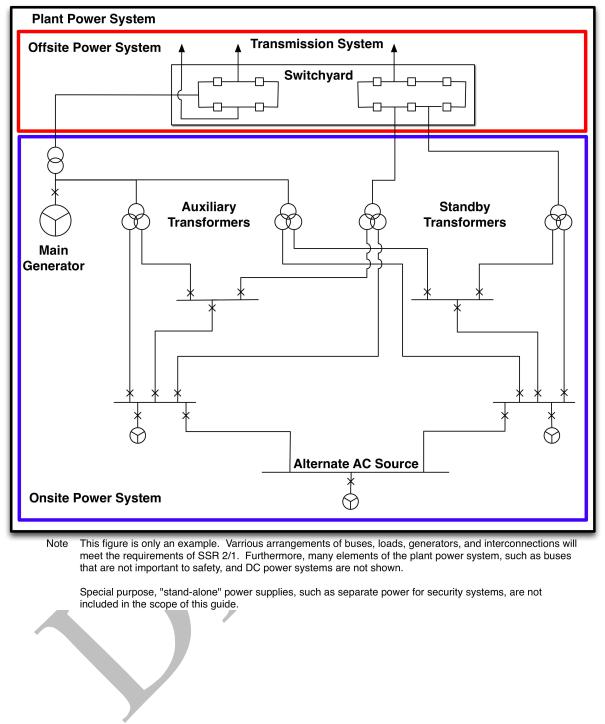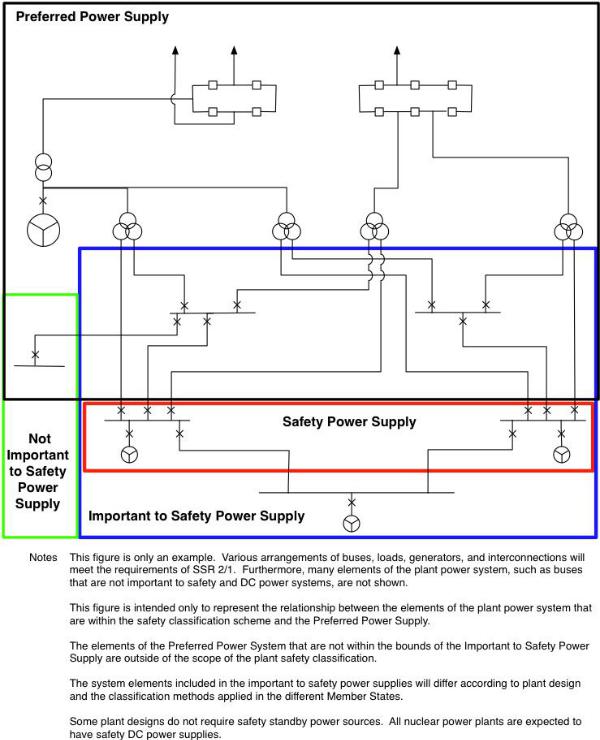
IAEA Design of Electrical Power Systems for Nuclear Power Plants
.pdf
Date: 2012-11-18
IAEA SAFETY STANDARDS
for protecting people and the environment
Draft I
Step 8:
submission to Member States for comment. Deadline 31 May 2013
Design of Electrical Power Systems for Nuclear Power Plants
DS430
DRAFT SAFETY GUIDE
New Safety Guide
Supersedes NS-G-1.8
IAEA
International Atomic Energy Agency
1

IAEA Draft DS430: I&C Safety Guide |
DRAFT |
2012-11-18 |
2

IAEA Draft DS430: I&C Safety Guide |
DRAFT |
2012-11-18 |
|
CONTENTS |
|
1. INTRODUCTION.......................................................................................................................................... |
|
1 |
BACKGROUND ................................................................................................................................................................. |
|
1 |
OBJECTIVE......................................................................................................................................................................... |
|
2 |
SCOPE .................................................................................................................................................................................. |
|
2 |
2. STRUCTURE...................................................................................................................................................................... |
|
3 |
NUCLEAR PLANT ELECTRICAL POWER SYSTEMS ........................................................................... |
7 |
|
DESCRIPTION OF PLANT ELECTRICAL POWER SYSTEM ............................................................................. |
7 |
|
Off-site power system..................................................................................................................................................... |
|
7 |
On-site power system ..................................................................................................................................................... |
|
7 |
Preferred power supply................................................................................................................................................. |
|
8 |
ROLE OF CODES AND STANDARDS......................................................................................................................... |
|
8 |
DESIGN CONSIDERATIONS IMPOSED BY NUCLEAR SAFETY...................................................................... |
9 |
|
DESIGN CONSIDERATIONS IMPOSED BY ELECTRICAL DESIGN CRITERIA ....................................... |
11 |
|
Power plant as a generating facility connected to the grid....................................................................... |
11 |
|
Personnel and equipment safety............................................................................................................................ |
|
11 |
3. CLASSIFICATION OF ELECTRICAL POWER SYSTEMS ................................................................... |
12 |
|
4. DESIGN BASES FOR ELECTRICAL POWER SYSTEMS..................................................................... |
13 |
|
5. GENERAL DESIGN GUIDELINES FOR ELECTRICAL POWER SYSTEMS...................................... |
17 |
|
GENERAL......................................................................................................................................................................... |
|
17 |
Anticipated electrical events ................................................................................................................................... |
|
17 |
Station blackout............................................................................................................................................................ |
|
18 |
DESIGN FOR RELIABILITY....................................................................................................................................... |
|
19 |
General .............................................................................................................................................................................. |
|
19 |
Redundancy..................................................................................................................................................................... |
|
20 |
Independence ................................................................................................................................................................. |
|
20 |
Diversity............................................................................................................................................................................ |
|
24 |
Common cause failures .............................................................................................................................................. |
|
25 |
Failure modes................................................................................................................................................................. |
|
26 |
Protection coordination ............................................................................................................................................ |
|
27 |
Reliability confirmation............................................................................................................................................. |
|
28 |
RATING ............................................................................................................................................................................ |
|
28 |
Motor loads ..................................................................................................................................................................... |
|
29 |
ELECTRICAL EQUIPMENT AND RACEWAYS ................................................................................................... |
30 |
|
General .............................................................................................................................................................................. |
|
30 |
Rating and sizing.......................................................................................................................................................... |
|
30 |
Installation ...................................................................................................................................................................... |
|
30 |
Cable separation ........................................................................................................................................................... |
|
31 |
GROUNDING PRACTICES.......................................................................................................................................... |
|
32 |
General .............................................................................................................................................................................. |
|
32 |
Electrical Safety ............................................................................................................................................................ |
|
32 |
Functionality .................................................................................................................................................................. |
|
33 |
LIGHTNING AND SURGE PROTECTION.............................................................................................................. |
|
33 |
EQUIPMENT QUALIFICATION ............................................................................................................................... |
|
34 |
General .............................................................................................................................................................................. |
|
34 |
Suitability and correctness....................................................................................................................................... |
|
36 |
3

IAEA Draft DS430: I&C Safety Guide |
DRAFT |
2012-11-18 |
|
Environmental qualification ................................................................................................................................... |
|
|
36 |
Internal and external hazards................................................................................................................................ |
|
|
37 |
Electromagnetic qualification ................................................................................................................................ |
|
|
38 |
DESIGN TO COPE WITH AGEING........................................................................................................................... |
|
|
40 |
CONTROL OF ACCESS................................................................................................................................................. |
|
|
41 |
SURVEILLANCE TESTING AND TESTABILITY................................................................................................. |
|
42 |
|
Test Provisions............................................................................................................................................................... |
|
|
42 |
Test program.................................................................................................................................................................. |
|
|
42 |
MAINTAINABILITY..................................................................................................................................................... |
|
|
44 |
PROVISIONS FOR REMOVAL FROM SERVICE FOR TESTING OR MAINTENANCE ........................... |
|
44 |
|
SHARING OF STRUCTURES, SYSTEMS AND COMPONENTS IN MULTI-UNIT PLANTS .................. |
45 |
||
MARKING AND IDENTIFICATION......................................................................................................................... |
|
|
46 |
CONTAINMENT ELECTRICAL PENETRATIONS ............................................................................................. |
|
46 |
|
DISTRIBUTION SYSTEMS......................................................................................................................................... |
|
|
47 |
Capability......................................................................................................................................................................... |
|
|
47 |
Protective devices of the main and branch circuits and loads.................................................................. |
|
47 |
|
CONTROLS AND MONITORING ............................................................................................................................. |
|
|
48 |
6. SAFETY RELATED STANDBY AC POWER SOURCES ..................................................................................... |
|
49 |
|
DESIGN GUIDELINES FOR PREFERRED POWER SUPPLIES......................................................... |
|
50 |
|
GENERAL......................................................................................................................................................................... |
|
|
50 |
RELIABILITY OF PROTECTION DEVICES AND HIGH VOLTAGE EQUIPMENT................................... |
|
50 |
|
OFF-SITE POWER SUPPLIES................................................................................................................................... |
|
|
51 |
AVAILABILITY............................................................................................................................................................... |
|
|
52 |
INDEPENDENCE .......................................................................................................................................................... |
|
|
53 |
SWITCHYARD................................................................................................................................................................ |
|
|
53 |
GRID STABILITY AND RELIABILITY.................................................................................................................... |
|
|
54 |
INTERFACE AND INTERACTION BETWEEN TRANSMISSION SYSTEM OPERATOR AND |
|||
NUCLEAR POWER PLANT OPERATOR............................................................................................................... |
|
|
54 |
7. RELIABILITY ASSESSMENT OF GRID CONNECTIONS.................................................................................. |
|
56 |
|
DESIGN GUIDELINES FOR ELECTRICAL SAFETY POWER SYSTEMS ......................................... |
|
56 |
|
GENERAL......................................................................................................................................................................... |
|
|
56 |
Anticipated electrical events ................................................................................................................................... |
|
|
56 |
Bus monitoring and switching................................................................................................................................ |
|
|
56 |
DESIGN FOR RELIABILITY....................................................................................................................................... |
|
|
58 |
Single failure criterion ............................................................................................................................................... |
|
|
58 |
Completion of protective action............................................................................................................................. |
|
|
60 |
SAFETY STANDBY AC POWER SOURCES........................................................................................................... |
|
|
60 |
General .............................................................................................................................................................................. |
|
|
60 |
Testing............................................................................................................................................................................... |
|
|
62 |
Performance criteria (transient and dynamic)............................................................................................... |
|
63 |
|
Relay protection of standby power sources ...................................................................................................... |
|
63 |
|
Support systems for standby AC power sources.............................................................................................. |
|
64 |
|
Fuel for standby AC power sources....................................................................................................................... |
|
|
64 |
DC POWER SYSTEMS.................................................................................................................................................. |
|
|
64 |
General .............................................................................................................................................................................. |
|
|
64 |
Battery............................................................................................................................................................................... |
|
|
64 |
Battery charger............................................................................................................................................................. |
|
|
65 |
4

IAEA Draft DS430: I&C Safety Guide |
DRAFT |
2012-11-18 |
Uninterruptible AC power system ......................................................................................................................... |
|
67 |
Protection of DC power systems and uninterruptible AC power system .............................................. |
67 |
|
8. ALTERNATE AC POWER SUPPLIES..................................................................................................... |
|
68 |
9. DESIGN CONFIRMATION AND DOCUMENTATION......................................................................... |
70 |
|
MANAGEMENT SYSTEM........................................................................................................................................... |
|
70 |
VERIFICATION.............................................................................................................................................................. |
|
70 |
Testing............................................................................................................................................................................... |
|
71 |
DESIGN DOCUMENTATION..................................................................................................................................... |
|
71 |
REFERENCES .................................................................................................................................................. |
|
75 |
ANNEX I. DEFENCE IN DEPTH IN ELECTRICAL POWER SYSTEMS................................................. |
77 |
|
FIRST LEVEL.................................................................................................................................................................. |
|
77 |
Design bases.................................................................................................................................................................... |
|
77 |
The grid............................................................................................................................................................................. |
|
78 |
On-site power systems ................................................................................................................................................ |
|
79 |
SECOND LEVEL............................................................................................................................................................. |
|
80 |
Fault clearing system and protection coordination...................................................................................... |
80 |
|
Power transfer capability ......................................................................................................................................... |
|
80 |
House-load operation possibilities........................................................................................................................ |
|
81 |
THIRD LEVEL ................................................................................................................................................................ |
|
81 |
On-site standby AC power supplies....................................................................................................................... |
|
81 |
Safety power systems.................................................................................................................................................. |
|
82 |
FOURTH LEVEL ............................................................................................................................................................ |
|
83 |
Alternate AC power supply....................................................................................................................................... |
|
83 |
ANNEX II. ELECTRICAL SYSTEM ANALYSES FOR DESIGN VERIFICATION .................................. |
85 |
|
LOAD FLOW STUDIES................................................................................................................................................ |
|
85 |
SHORT CIRCUIT STUDIES ........................................................................................................................................ |
|
86 |
ELECTRICAL PROTECTION COORDINATION STUDIES............................................................................... |
86 |
|
LOSS OF VOLTAGE AND DEGRADED VOLTAGE STUDIES .......................................................................... |
88 |
|
TRANSIENT STABILITY STUDIES......................................................................................................................... |
|
89 |
LIGHTNING PROTECTION AND SYSTEM GROUNDING STUDIES............................................................ |
90 |
|
ELECTROMAGNETIC COMPATIBILITY STUDIES........................................................................................... |
91 |
|
LIST OF DEFINITIONS ................................................................................................................................. |
|
93 |
5

1. INTRODUCTION
BACKGROUND
1.1.This Safety Guide is issued in support of the Safety Requirements publication on Safety of Nuclear Power Plants: Design SSR-2/1, Ref. [1], which establishes design requirements for nuclear power plants.
1.2.This Safety Guide provides recommendations on the characteristics that nuclear plant Electrical Power systems, and the processes for developing these systems, should have in order to meet the requirements of Safety Requirements SSR-2/1, Ref. [1]. It reflects international best practices and a consensus that the recommended characteristics (or equivalent) should be achieved in the development of electrical power systems. The Safety Guide does not provide details of implementation processes, development methods, or technology, except as explanation.
1.3.This publication is a revision of a previous Safety Guide issued in 2004 as Safety Guide NS-G-1.8, Ref. [2], Emergency Power Systems at Nuclear Power Plants, and supersedes it. This revision takes into account the developments in the design of Emergency Power Systems in nuclear power plants and expands the scope to include all electrical power systems that provide power to systems Important to Safety (See Figs 1 and 2).
1.4.NS-G-1.8, Ref. [2] also included guidance on non-electrical systems that provided emergency power. Guidance for such systems is to be located in a new Safety Guide on auxiliary systems.
1.5.Electrical systems that supply power to systems important to safety are essential to the safety of nuclear power plants. These systems include both the on-site and off-site power supply systems. The on-site and off-site systems work together to provide necessary power, in all plant conditions, so that the plant can be maintained in a safe state. Off-site power systems are not plant equipment. They are, nevertheless, essential to the safety of a nuclear power plant and have an important role in the defence in depth concept.
1.6.The preferred power supply identified in this Safety Guide is the power supply from the transmission system up to the safety classified electrical power system. It is composed of transmission system, switchyard, main generator and distribution system up to safety classified electrical power system. The portions of the preferred power supply that are part of the off-site power system (e.g., transmission system and switchyard) are not plant equipment and, therefore, are not part of the safety classification scheme (see Fig. 2). The location of the boundary between the off-site and on-site power supplies will be a plant specific decision.
1.7.It might not be practicable to apply all the requirements of this Safety Guide to nuclear power plants that are already in operation or under construction; in addition, it might not be feasible to modify designs that have already been approved by regulatory bodies. For the safety analysis of such designs, it is expected that a comparison will be made with the current standards, for example as part
1

of the periodic safety review for the plant, to determine whether the safe operation of the plant could be further enhanced by means of reasonably practicable safety improvements.
OBJECTIVE
1.8. The objective of this Safety Guide is to give recommendations and guidance on meeting the requirements for the design of electrical power systems established in Requirements 41 and 68, paras 6.43–6.45, and the general requirements of Sections 2–5 of SSR-2/1, Ref. [1]. It is intended for the use by those involved in the design, operation, maintenance, modification, assessment, and licensing of nuclear plants, including designers, reviewers, safety assessors, regulators and operators.
SCOPE
1.9.The Safety Guide makes recommendations and provides guidance on the electrical power systems provisions necessary for both new and operating nuclear power plants. It applies to all electrical power systems important to safety in nuclear power plants and to the preferred power supply.
1.10.This Safety Guide applies to all types of nuclear power plants. The extent of the electrical power systems important to safety and of safety power systems, given by classification of the electrical systems, differs between different designs. The minimum design requirements for electrical systems necessary at different voltage levels, for maintaining defence in depth and diversity, are outlined in this Safety Guide. In all cases, this Safety Guide should be used together with the plant’s Safety Analysis Report in order to determine the safety significance and importance of different power supplies. For example, in plants with passive engineered safety features, the classification of the electrical power systems may be substantially different than shown in Fig. 2.
1.11.Additional recommendations applicable to electronic devices used in the control and protection of the plant electrical power systems are given in the Safety Guide for I&C systems, DS431, Ref. [3].
1.12.Figures 1, 2 and 3 show examples of nuclear power plant electrical power systems to illustrate the scope of this Safety Guide and terminology used in this Safety Guide. Further explanation is found in the section on definitions and abbreviations.
1.13.This Safety Guide is focused on the electrical power systems. Guidance on the specification of loads is outside the scope, but it is necessary that such specifications align with the design guidelines for the power systems.
1.14.Electrical power for security systems (e.g., fences, surveillance systems, entrance control) is outside the scope of this Safety Guide.
1.15.This Safety Guide should be used in conjunction with the other relevant safety standards issued in the IAEA Safety Standards Series.
1.16.Additional guidance for the design and development of electrical power systems and equipment are available from Member States and standards development organizations. Their publications give
2

much greater detail than is appropriate for IAEA safety standards. It is expected that this Safety Guide will be used in conjunction with an appropriate set of more detailed industrial standards.
STRUCTURE
1.17.Section 2 introduces the main systems of a typical plant electrical power system and describes the fundamental goals to be met by each system.
1.18.Section 3 describes the application of safety classification to electrical power systems.
1.19.Section 4 outlines the content that should be included in the design bases for electrical power systems.
1.20.Section 5 provides general recommendations that apply to all electrical power systems. These recommendations are the minimum recommendations for systems that are not covered in sections 6 thru 9. For systems that are covered in sections 6 thru 9 the recommendations of section 5 should be used in conjunction with the specific recommendations.
1.21.Section 6 provides recommendations for the preferred power supplies, which are the normal supplies for all plant systems important to safety and are, if available, always the first and best choice of all plant power supplies.
1.22.Section 7 provides recommendations that are specific to the design of safety power systems, including safety standby power supplies.
1.23.Section 8 provides recommendations that are specific to the design of alternate AC power supplies. This supplements the guidance of section 5 for these systems. Alternate AC power supplies are often provided to protect against the simultaneous failure of off-site and emergency on-site AC power supplies.
1.24.Section 9 provides recommendations for activities to confirm the adequacy of the electrical power system design and the system level documentation that should be provided both to support the safety case for the plant and to support operations, maintenance, testing, and verification.
1.25.Annex I discusses the relationship between the design of electrical power systems and the concept of defence in depth as given in SSR-2/1, Ref. [1].
1.26.Annex II gives an example of electrical system analyses for design verification of the nuclear
plant.
3

FIG. 1. Relationship of the plant power system, the off-site power system and the on-site power system.
4

FIG. 2. Relationship of power supplies important to safety, safety power supplies, and the preferred power supply.
5
